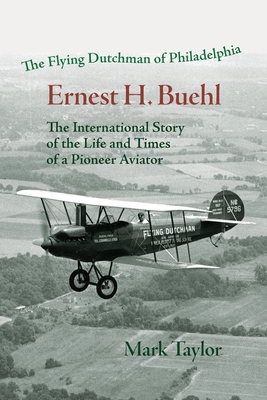
Mark Taylor grew up in Billings, Montana and he is a founding member of This House of Books. He earned a B.A. from Rocky Mountain College, majoring in art and English. Attending Cal Poly Humboldt University, Mark obtained his master's degree in psychology. In his 35-year career serving rural eastern Montana, Mark worked in residential child care, operated a mental health center satellite office, and worked as a specialist in more schools than he can remember. In 1997, he was selected as Montana’s School Psychologist of the Year. Now retired, Mark, has written the definitive biography of Ernest Herman Buehl Sr., a pioneer aviator and important figure in the development of general (civilian) aviation.
Full Description of The Flying Dutchman of Philadelphia,
Ernest H. Buehl
Trained as an aviation mechanic in Germany in the 1910s, Buehl arrived in the United States in 1920, at a time when we were just inventing civilian uses for airplanes. Later, as a pilot, he trained thousands of fliers. His work, both in Europe and North America, directly helped push back major physical and social frontiers.
Buehl’s work made the first flight into the stratosphere in an airplane and other record-breaking events possible. As a co-pilot, he flew the first round trip transcontinental passenger flight in North America, helped survey the first New York to San Francisco airmail route, and pioneered routes into Canada’s far north. Later, as an owner of four civilian airports and then during World War II, he oversaw training for thousands of pilots.
Buehl’s most famous student was C. Alfred (“Chief”) Anderson, the man who became the lead trainer at Tuskegee during World War II. In part because of Buehl’s insistence that he be examined fairly, Anderson, who became known as the “Father of Black Aviation,” was the first black pilot to earn an Air Transport License.
Few books feature the development of civilian aviation rather than military aviation, but this is one. Buehl’s work and contributions are set in the context of his time, and the discussion points out its relevance to today’s world. Technical information is explained in the text, so the book should be accessible to those who come from nontechnical backgrounds.
One hundred eighty-five photographs and images illustrate the book. Nearly all of these are from Buehl’s
personal collection, and many are rare. The book is extensively documented and explained, drawing on hundreds of sources, including books, broadcasts and recordings, documents, letters and manuscripts, interviews, journal articles, magazines, maps, newspaper articles, and websites. The book includes an index.
Review Quotes
Mr. Taylor’s book captures the flavors of early aviation and touches on a pivotal figure that few have heard of. This book will be at home in the collection of anyone who craves a deeper understanding of how modern aviation was enabled by pioneers such as Buehl.
—Steven J. Drinnon, Lt Col, USAF, Ret.,
former chief editor ofAir and Space Power Journal (ASPJ),
the professional journal of the United States Air Force
I recommend this book for readers who are interested in the history of civilian aviation. It brings forward a great deal of information that is not discussed in other histories I have seen.
—Dan Hargrove, Lt. Col. USAF, Ret.,
former Deputy Operations Group Commander
at Andrews Air Force Base and pilot of Air Force Two,
and current Director of Aviation, Rocky Mountain College

